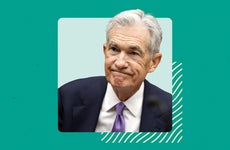The Federal Reserve and Your Money
The U.S. central bank has lifted interest rates to a 22-year high, impacting how much you pay to borrow money and how much you earn when you save. Get advice and stay informed on what to do with your wallet.
The Fed's impact on your wallet
The latest interest rates
Every time the Federal Reserve adjusts interest rates, borrowing and savings rates move in lockstep. Compare Bankrate data to see how the latest Fed decision is impacting rates on key consumer products.
As economy slow, mortgage rates retreat
This week's HELOC news and analysis
Current credit card interest rates
Current car loan interest rates
What is the average interest rate for savings accounts?
Essential reading
Follow us for the latest financial news:
Latest Articles
-

How the Federal Reserve impacts personal loans
The Federal Reserve raised interest rates several times. These interest rate changes are likely to affect the rates of personal loans.
4 min read Apr 24, 2024 -

Why now might be a good time to consider longer-term CDs
If you’ve been thinking of getting a longer-term CD, you may want to make a move.
4 min read Apr 02, 2024 -

When will the Fed cut interest rates? Not so fast, some officials say, as inflation stays stubborn
Some Fed officials are starting to rethink just how much they can cut rates.
7 min read Mar 29, 2024 -

How does the Federal Reserve affect mortgages?
The Federal Reserve’s decisions have ripple effects, including for mortgages.
3 min read Mar 21, 2024 -

What the Fed’s continued rate pause means for homebuyers and sellers
The Fed again held steady with no new rate hike at its second meeting of 2024.
4 min read Mar 20, 2024 -

How the Federal Reserve affects HELOCs and home equity loans
If you’re looking at HE loans or have a variable-rate line of credit, pay attention to the Fed.
5 min read Mar 20, 2024 -

Fed remains on hold, keeps forecast for three rate cuts in 2024
How will the Fed juggle hotter inflation with a rising unemployment rate?
7 min read Mar 20, 2024 -

How the Fed rate changes impact student loan interest rates
The Federal Reserve’s actions can influence student loan interest rates.
5 min read Mar 20, 2024 -

Though Fed holds lending rates steady, subprime cardholders continue to feel sting of high interest rates
Subprime borrowers are particularly affected by interest rate changes. Here’s how to prepare.
4 min read Mar 20, 2024 -

Why are credit card APRs so high?
Credit card interest rates have a high mark up over the prime rate. Why are card APRs so high?
5 min read Mar 20, 2024 -

The Federal Reserve’s latest dot plot, explained – and what it says about interest rates
This Fed communication tool is important, but be cautious when interpreting it.
7 min read Mar 20, 2024 -

Biggest winners and losers from the Fed’s interest rate decision
While it stood pat this time, the Federal Reserve has raised rates 11 times in this cycle.
6 min read Mar 20, 2024 -

How the Fed impacts stocks, crypto and other investments
The best way for most investors to approach this type of market is to stick to the long-term plan.
7 min read Mar 20, 2024 -

Fed’s interest rate history: The federal funds rate from 1981 to the present
The key benchmark has been as high as 20 percent — and as low as 0 percent.
12 min read Mar 20, 2024 -

How the Federal Reserve impacts savings account interest rates
For savers, here’s what to consider when the Fed raises interest rates.
4 min read Mar 20, 2024 -

How does the Fed interest rate affect car loans?
Does the Fed interest rate affect car loans? Yes, it does: It has a domino effect that can raise or lower auto loan rates.
3 min read Mar 20, 2024 -

What is the Federal Reserve? A guide to the world’s most powerful central bank
The Fed plays a role in influencing every financial decision you make.
12 min read Mar 20, 2024 -

6 key ways the Federal Reserve impacts your money
Every financial decision you make comes back to the Federal Reserve.
11 min read Mar 19, 2024 -

Preview of the March Fed meeting: The top 3 trends to watch as hotter inflation delays the Fed’s rate cuts
Does the Fed still think it can cut interest rates three times this year?
6 min read Mar 18, 2024 -

Should you buy a house during a recession?
How might a recession affect the housing market? Find out what the experts think.
7 min read Mar 11, 2024
Related Topics
Helpful Links
- How to save money
- How to build an emergency fund
- Savings tips for different goals
- How to get the best mortgage rate
- How to get the best refi rate
- How often to compare mortgage rates
- Best low-risk investments
- How to pay off debt
- How much does it cost to buy a home?
- What's next for the housing market?
- How to make your paycheck last
- What debt should you pay off first?
- How to pay off credit card debt
- How to boost your credit score
- Tips for scoring a lower credit card rate
- Fed's interest rate history
- Inflation’s impact on auto rates
- When will car interest rates start dropping?
- Are interest rates going up on personal loans?
- Historical CD interest rates




